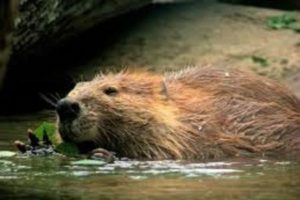Beaver Removal & Info
Beavers, North America’s largest rodent, are second only to humans in their ability to engineer and alter landscapes. The wetland ecosystems beavers create benefit surrounding areas by raising water tables, replenishing aquifers, and creating environments where many different species thrive. Beavers mate for life and raise their young, known as kits, in their underwater lodges.
Biology & Behavior
The beaver (Castor Canadensis, is the largest North American rodent. Most adults weigh from 35 to 50 pounds with some occasionally reaching 70 to 85 pounds. Individuals have been known to reach over 100 pounds. The beaver is a stocky rodent adapted for aquatic environments. Many of the beaver’s features enable it to remain submerged for long periods of time. It has a valvular nose and ears, and lips that close behind the four large incisor teeth. Each of the four feet have five digits with the hind feet webbed between digits and a split second claw on each hind foot. The front feet are small in comparison to the hind feet. The underfur is dense and generally gray in color, whereas the guard hair is long, course and ranging in color from yellowish brown to black, with reddish brown the most common coloration. The prominent tail is flattened dorsoventrally, scaled, and almost hairless. It is used as a prop while the beaver is sitting upright and for a rudder when swimming. Beavers also use their tail to warn others of danger by abruptly slapping the surface of the water. The beaver’s large front (incisor) teeth, bring orange on the front, grow continuously throughout its life. These incisors are beveled so that they are continuously sharpened as the beaver gnaws and chews while feeding, girdling and cutting trees. Beavers have a relatively long life span, with individuals known to have lived to 21 years. Most, however, do not live beyond 10 years. The beaver is unparalleled at dam building and can build dams on fast moving streams as well as slow moving ones. They also build lodges and bank dens, depending on the available habitat. All lodges and bank dens have at least two entrances and may have four or more. The lodge or bank den is used primarily for raising young, sleeping, and food storage during severe weather. An important factor about beavers is their territoriality. A colony generally consists of four to eight related beavers, who resist additions or outsiders to the colony shortly after they become sexually mature, at about 2 years old. They often move to another area to begin a new pond and colony. However, some become solitary hermits inhabiting old abandoned ponds or farm ponds if available. Beavers have only a few natural predators aside from humans, including coyotes, bobcats, river otters, and mink, who prey on young kittens. In other areas, bears, mountain lions, wolves, and wolverines may prey on beavers.
Noises
What Does a Beaver Sound Like?
Beavers are in fact quite vocal. They communicate with each other via distinct grunts, grumbles, and barks. It sounds sort of like they are whining.
Tracks

Scat
Beaver scat is made up entirely of wood chips. The oval pellets are 1 to 1 1/4 inches in length and 3/4 of an inch in diameter. They would most likely be found in route to or near Beaver chews if found at all since Beavers spend the majority of their time in water.
Damage
Most of the damage caused by beavers is a result of dam building, bank burrowing, and tree cutting, or flooding. In addition, beavers threaten human health by contaminating water supplies with Giardia. Beavers are hosts for several ectoparasites and internal parasites including nematodes, trematodes, and coccidians.
Pictures
Commonly ASKED QUESTIONS?
What do you do with trapped animals?
That answer depends on the state in which you live. Each state has their own laws that dictate what we must do when it comes to controlling wildlife on your property. In some states, we can trap, transfer and release the animals. In some states we can trap the animals, but we can only release them back onto your own property. If you don’t want the animal released on your property, it must be humanely euthanized. Sometimes we don’t even need to trap the animal and a simple exclusion device (one-way door) can be installed to allow the animal to exit your home and be locked out.
How much does it cost to remove an animal?
There are a number of factors that determine pricing; location of the animal (i.e. – chimney, attic, crawl, wall void, living area), condition of the animal (i.e. – sick, aggressive, dead), location and condition of the property and time of year (i.e. – weather condition, offspring present?). Generally speaking, pricing will vary by location and species for just the animal removal and that pricing usually does not include the entry repair.
I think I have birds in my chimney, can you get them out?
The answer to that question is most likely “Yes”, but are you sure what you’re hearing is birds? Raccoons easily invade chimneys and they have their litters on the smoke shelf of fireplaces. The sounds baby raccoons make are often mistaken for birds in chimneys and removal can be difficult. The only birds that nest in chimneys are chimney swifts and they’re federally protected, so removal can’t be performed, but exclusion can be – once they depart. If you have a pre-fabricated chimney and birds fall between the cooling tubes, removal is nearly impossible.
How soon can you get here?
Office hours vary from franchise to franchise, but generally speaking, office hours are 8am – 6pm M-F and 9am – 3pm on Saturdays.
Clients Testimonials
OUR EXPERTS WILL SOLVE THEM IN NO TIME.
Have Any Pest Problems?
Navigations
Contact Information

At Critter Removers we're committed to providing you with the highest level of services and solutions to best fit your pest or critter control needs.

